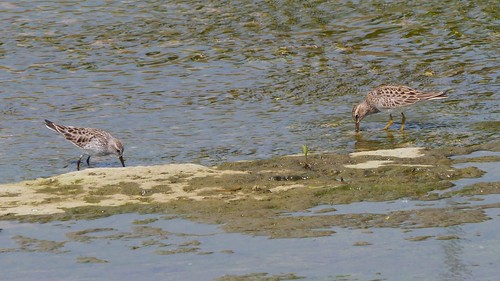May is an exciting month to be a birder in Austin. The first half is the peak of spring migration, so all sorts of birds you don't see at other times of the year are moving through the area in this small window of time. Most migratory songbirds fly north by night and spend the day foraging and recuperating in patches of habitat they find along the way. The first half-mile of Lake Creek Trail is a prime piece of habitat and right now it's loaded with migratory songbirds. Here's a list of bird species Austin-area birders have reported to eBird from Lake Creek Trail so far this month:
May 2012 eBird Data for Lake Creek Trail
Wow, 16 species of warblers! 5 species of vireo! Rose-breasted Grosbeak! Baltimore Oriole! One of the most exciting warblers was a female Golden-winged Warbler that Barry Noret found on May 9. This beautiful species is in decline, so it's a rare treat to get to see one on its way north. Barry got this photo.
I was out on the trail this morning and that first half-mile of the trail is still hopping! A singing Chestnut-sided Warbler and my first Mourning Warbler of the year were highlights. But songbirds aren't the only migrants and mid-May is one of the few times of the year that a nice diversity of sandpipers can be found on Lake Creek. (I used to think you'd only ever find a sandpiper on the beach, but most are migratory and breed inland, in Canada and the northern U.S.) So I walked downstream to check out a few spots where the water is shallow enough to be good sandpiper habitat.
I found a group of Least Sandpipers, which are almost year-round residents here. They winter here and throughout the rest of the year, there are usually a few Least Sandpipers headed north or south and resting on Lake Creek. I was excited to find three White-rumped Sandpipers with them. These birds winter in southern South America and breed in the Canadian arctic. I think it's amazing that a few use our neighborhood creek on their way north. Here's one I photographed this morning:
And here's a shot showing its namesake, the white rump, which is usually obscured unless the bird is flying:
Semipalmated Sandpipers migrate almost as far, and I have fewer records of them on Lake Creek. I was excited to find this one foraging with the Leasts. The Semipalmated is the top bird. The differences are subtle -- black legs, a less curved bill, and less brown in the breeding plumage are all clues.
Pectoral Sandpiper, Solitary Sandpipers, and Spotted Sandpipers were also in this group. Distinguishing the different species of sandpipers can be very challenging. I didn't know them very well until I started to find them on Lake Creek a few years ago. Only a few show up at a time, and I'm usually so excited to find them on my home turf that I'm happy to study them carefully. See this shot of a White-rumped Sandpiper on the left and a Pectoral Sandpiper on the right.
They're so similar, but when you take the time to study them, you start to appreciate the differences and their subtle beauty. Here are all the photos I took this morning. And here's my complete bird list.





1 comment:
These are great pictures showing the differences between the species. I think photography and being able to compare side by side without movement is a real help, obviously! I had a group of 10 sandpiper species fly over a few days ago. At a good distance and quiet so no ID.
Post a Comment